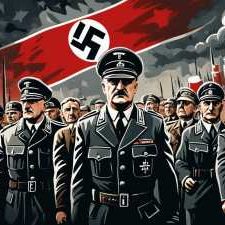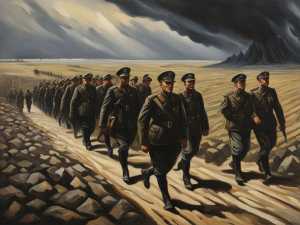Demystifing Nazi Germany – What You Need to Know

It was Arthur Moeller van den Bruck, a cultural critic, who came up with the term „Third Reich,” mixing German thought with nationalism. He wanted to avoid Marxism and Western democracy. His words were taken over by a terrible regime. He sadly didn’t see the huge damage Hitler caused, but his worries about power were sadly right.
Looking into Nazi Germany history, we must think about the big political changes and wars. But we also need to consider the deep human stories and moral questions that came up. By understanding, we remember those who suffered and make sure history’s lessons stay with us.
Introduction to Nazi Germany
The story of Nazi Germany starts after World War I and the trouble of the Weimar Republic. This time was perfect for Adolf Hitler to become powerful. Hitler’s book „Mein Kampf” laid out his plans for a new Germany, called the Third Reich.
The term 'Third Reich’ was first used by Arthur Moeller van den Bruck. The Nazis took it to mean a new start for Germany. Hitler wanted to be seen as the next leader after the Holy Roman and German Empires. This idea was part of his plan to make Germany proud again and lead Europe.
Hitler’s rule had a huge cost in human lives. From 1941 to 1945, six million European Jews were killed in the „Final Solution”. This was part of a bigger plan to harm Jews and others from 1933 to 1945. Millions faced persecution during the Holocaust, with mass killings in over 1,500 places.
By 1942, Nazi Germany controlled much of Europe and parts of North Africa. Here’s a look at its size, people, and beliefs at the time:
| Year | Area (km²) | Population | Religious Composition |
|---|---|---|---|
| 1939 | 633,786 | 79,375,281 |
|
| 1940 | 823,505 | 109,518,183 |
|
The start of Nazi Germany came from the chaos after World War I and the Weimar Republic’s troubles. Adolf Hitler’s leadership led to a very dark time in history. This part helps us understand the big effects and lasting impact of Hitler’s rule.
Historical Context and German Empires
Understanding Nazi Germany means looking closely at the history of German Empires. Adolf Hitler linked his rule to key events in Germany’s past. He used this history to support his claim of leadership.
The First Reich, or the Holy Roman Empire, started with Charlemagne’s coronation in 800 AD. It covered a big area in central Europe for over a thousand years. This set the stage for Germany’s future goals.
In the 19th century, the Second Reich, or the German Empire, began. It united Germany under Otto von Bismarck in 1871, after beating France in the Franco-Prussian War. This was a big step for Germany, making it a leading power in Europe.
Hitler wanted to create a “Third Reich” even bigger than before. He aimed for military growth and more power, starting after becoming chancellor on January 30, 1933.
The Nazi regime was driven by a wish to bring back the greatness of the Holy Roman Empire and the German Empire. This period is both interesting and sad. It shows how these earlier empires influenced Hitler’s beliefs and actions.
Here is a look at key empires in German history:
| Empire | Duration | Key Figures | Significance |
|---|---|---|---|
| First Reich (Holy Roman Empire) | 800 AD – 1806 | Charlemagne, Frederick I Barbarossa | Foundation of Germanic governance and culture. |
| Second Reich (German Empire) | 1871 – 1918 | Otto von Bismarck, Wilhelm II | Unification of Germany, rise as a European power. |
| Third Reich (Nazi Germany) | 1933 – 1945 | Adolf Hitler | Expansionist ideologies leading to WWII and the Holocaust. |
Hitler’s Mein Kampf
Adolf Hitler’s Mein Kampf is key to understanding the Nazi Party’s beliefs. It was written while he was in prison after a failed coup in 1923. The book shares his views on Jews, politics, and World War I. It was published in two volumes in 1925 and 1926.
The first edition of Mein Kampf sold 10,000 copies, leading to a second printing. Sales were slow at first but grew as the Nazi Party gained power. By 1932, about 230,000 copies had been sold. With Hitler as chancellor in 1933, sales jumped to over 850,000, making him a millionaire. By 1944, more than 12 million copies were printed.
Edited by Emil Maurice and Rudolf Hess, Mein Kampf became a key propaganda tool. Hitler’s anti-Semitic views were central, influenced by false sources like the Protocols of the Elders of Zion. This helped make these beliefs a core part of Nazi ideology.
After World War II, the Allies banned Mein Kampf. The copyright went to Bavaria, but it ended in 2015, allowing the book to be published again. New editions included notes to help readers understand the book better, sparking debates on censorship and teaching history.
The story of Mein Kampf shows how books can influence politics and spread harmful ideas. By studying the book’s history, we learn about the Nazi Party’s rise and its anti-Semitic beliefs.
| Year | Milestone | Copies Sold |
|---|---|---|
| 1924 | Hitler begins writing | – |
| 1925 | First volume published | 10,000 |
| 1932 | Nazi Party gains power | 230,000 |
| 1933 | Hitler becomes Chancellor | 850,000 |
| 1944 | End of World War II | 12 million |
| 2016 | Copyright expires | – |
Life under Nazi Germany
Daily life in Nazi Germany was full of control, propaganda, and state intervention. Nazi policies deeply affected public and private life. From 1933 to 1939, the German people faced many changes. These changes were bad for personal freedoms and society.
Propaganda and censored media were everywhere in Nazi Germany. Joseph Goebbels, the Minister of Propaganda, was key in shaping opinions. He banned materials that went against Nazi beliefs. The media spread the regime’s messages, and opposing views faced harsh punishment.
The Nazi impact was clear in how they treated the youth. Boys and girls aged 6-10 joined the Young Folk, and kids as young as 10 were in the Hitler Youth. These groups taught Nazi beliefs through brainwashing. Kids were forced to join sports, teaching them discipline and loyalty to the regime.
The Nazi economy had both good and bad sides. By 1939, Germany had no official unemployment, hitting Hitler’s goal. Big projects like the autobahn created jobs, and rearming brought in millions of jobs, boosting the economy. But, wages fell, hours got longer, and accidents at work went up, making life harder.
Nazi policies affected different groups in different ways. Big businesses got more control and saw wages go up by 50%. But, small businesses closed due to tough rules. Farmers got better prices for their produce but were stuck by the Hereditary Farm Law, stopping them from selling their farms.
Labour under the Nazis changed a lot. The German Labour Front (DAF) took over trades unions, setting wages based on what employers wanted. Workers who spoke out about their working conditions got blacklisted, showing a loss of rights in the rearmament industries.
Aftermath and Legacy of Nazi Germany
The World War II consequences are still felt today. Six million Jews were killed in the Holocaust. This was a third of the world’s Jews in 1939. It shows the deadly effects of hate and intolerance.
This tragedy has made us remember the Holocaust. It teaches us to watch out for hate in the future. We must not forget what happened.
Wars destroyed many cities and countries, not just Germany. In Poland, 85% of Warsaw was destroyed. A report in 1947 said 6,028,000 Poles and Jews died from a population of 27,007,000.
The Soviet Union also suffered a lot. About 26 million Soviet citizens died, including 10.6 million soldiers. This shows the big impact of Nazi Germany on Eastern Europe and the world.
After the war, Germany had to rebuild. The people faced many challenges, like losing people and feeling down. They had to deal with the past and plan for the future.
FAQ
What does the term „Third Reich” signify?
Adolf Hitler used „Third Reich” to link his rule to German history. He claimed it was the third empire after the Holy Roman and German ones. Arthur Moeller van den Bruck first used the term, but Hitler made it famous.
How did Adolf Hitler rise to power in Nazi Germany?
Hitler became powerful in 1933 with his strong vision for the Third Reich. He changed Germany’s history to support his rule. This led to a big change in the country’s politics.
What were the First and Second Reichs in German history?
The First Reich was the Holy Roman Empire, from 962 to 1806. The Second Reich was the German Empire, from 1871 to 1918. Hitler linked these to his regime to show ongoing German power.
What is 'Mein Kampf’ and what impact did it have?
’Mein Kampf’ is a book by Adolf Hitler, published in 1925. It shares his anti-Semitic views, thoughts on World War I, and Nazi Party plans. The book spread harmful ideas and shaped Nazi Germany’s policies and propaganda.
How did life change for the German population under Nazi rule?
Under Nazi Germany, life was tough. The government controlled everything, watched people closely, and spread its beliefs. 'Mein Kampf’ and propaganda changed people’s lives, making them live in fear.
What were some of the consequences of World War II and the legacy of Nazi Germany?
Nazi Germany’s effects lasted long after World War II. The country faced trauma and debate, especially about 'Mein Kampf’. Its republication shows how we carefully handle the book to respect survivors and understand Nazi rule’s effects.

